Podcast
Questions and Answers
What is the final common oxidative pathway for carbohydrates, fats, and amino acids?
What is the final common oxidative pathway for carbohydrates, fats, and amino acids?
- Glycolysis
- Electron transport chain
- Tricarboxylic acid cycle (correct)
- Fatty acid oxidation
What is the product of the oxidation of acetyl CoA in the TCA cycle?
What is the product of the oxidation of acetyl CoA in the TCA cycle?
- ATP + NADH
- CO2 + ATP
- NADH + FADH2
- CO2 + H2O (correct)
What is the site of the TCA cycle?
What is the site of the TCA cycle?
- Mitochondrial outer membrane
- Mitochondrial matrix (correct)
- Cytosol
- Mitochondrial inner membrane
What is the intermediate formed immediately after the addition of H2O to cis-aconitate?
What is the intermediate formed immediately after the addition of H2O to cis-aconitate?
What is the next intermediate formed after isocitrate in the TCA cycle?
What is the next intermediate formed after isocitrate in the TCA cycle?
What is the net gain of ATP from the complete oxidation of glucose?
What is the net gain of ATP from the complete oxidation of glucose?
What is the role of anaplerotic reactions in the citric acid cycle?
What is the role of anaplerotic reactions in the citric acid cycle?
What is the byproduct of the spontaneous decarboxylation of oxalosuccinate?
What is the byproduct of the spontaneous decarboxylation of oxalosuccinate?
What is the amphibolic nature of the citric acid cycle?
What is the amphibolic nature of the citric acid cycle?
What is the effect of fluoroacetate on the citric acid cycle?
What is the effect of fluoroacetate on the citric acid cycle?
Flashcards are hidden until you start studying




